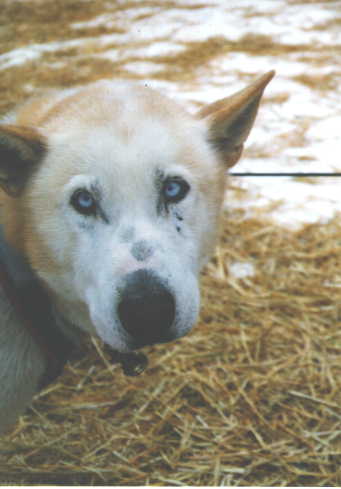
As I observed the dogs in their day-to-day life, I began to have serious doubts about their treatment. I am not the sort of person who is against working animals on principal but these were extreme conditions and I had to consider if they constituted abuse.
A sled dog’s life is hard and there’s no denying that. Below I have listed several conditions that made me pause and what I concluded about each.
1. The nights are cold and the winds harsh and the dogs are obviously miserable in the morning. Observation: The mushers do plan so that the picket lines are placed in sheltered areas and bedding is provided for the dogs to make nests with. In addition the mushers feed the dogs at 11:00 PM and again at 6:00 AM to insure that they have plenty of calories to make it through the night.
2. The dog’s feet sometimes suffer from the snow and ice. Ice balls form between the pads and sometimes the pads even bleed after a run. Observation: The mushers examine each dog’s pads carefully after each run to remove ice balls and look for damage. They would not run a dog with hurt feet.
3. The mushers dominate their dogs through intimidation and the dogs obviously fear them. I watched the interaction between the mushers and dogs very carefully. Yes the mushers do intimidate the dogs but this is how a pack is run. The mushers must establish themselves as the leader of the pack. If two of the dogs begin to fight, as they do for pack position, the musher must be able to get into the middle of it and not fear attack.
I considered all of this and decided that I could continue to dogsled. If their living conditions are harsh, they are certainly no harsher than that of their cousins in the wild. Wolves and coyotes do not get bedding and food provided through the night. The fact that the mushers carefully check each dog’s pads at the end of each run, a long and laborious process, shows a real concern for their welfare. To be sure they may be doing no more than taking care of stock, but the care is there and thorough regardless of the motivation.
I think that it is the dogs themselves who finally made up my mind. They greet the mushers in the morning with intense enthusiasm. If, for any reason, a dog must be left behind on a run, the dog is inconsolable and howls piteously when the sleds pull out. It is obvious that they want to run, to be a part of the pack. If they obviously desire to be a part of this activity, and they do, then I can be a part of it too.
Ultimately we must each decide for ourselves what our feelings are about sledding. I cannot decide for you but I do recommend that you examine the activity and the dogs first hand before you decide that dog sledding is wrong.
Top